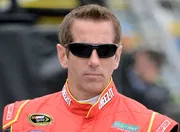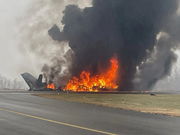
Imago
Joey Logano denny Hamlin kyle larson

Imago
Joey Logano denny Hamlin kyle larson
Joey Logano’s move in the final restart at Phoenix turned into one of the most talked-about moments of the championship weekend. It set off plenty of debate, all around how it contributed to Denny Hamlin’s title loss. Kyle Larson later broke down what really happened during that crucial restart involving Denny Hamlin, offering fans a glimpse into the split-second decisions that can define a NASCAR playoff race.
Watch What’s Trending Now!
Larson’s detailed analysis peeled back the layers of that moment, showing how strategies, reactions, and small shifts in momentum can completely change the race’s direction. In the end, it was a reminder of just how razor-thin the margin is between victory and heartbreak when everything is on the line.
ADVERTISEMENT
Kyle Larson breaks down what really happened at Phoenix
On the Dale Jr Download podcast, Larson revisited that overtime restart where everything unfolded. The reason he could nail that restart is because of the learning he got from a two-tire restart prior to that, which helped him understand how to generate better speed running in the top lane. That lesson came in handy when he needed it. As the field bunched up for the restart, Larson kept an eye on Denny Hamlin, who lined up on the bottom lane.
“I was less surprised by the run I had on the outside,” Larson said, “but definitely surprised by how little momentum Denny had through one and two.” That small imbalance came from an aggressive move by Joey Logano. According to Larson, Logano’s dive below the apron forced Hamlin lower than intended, disrupting his line.
“Joey went below the apron and it kinda took Denny down lower… I think maybe he got a little bit tight down there, and from there… you just bogged down.” With Hamlin struggling for grip, Larson’s car hooked up perfectly on the high side, giving him the traction and momentum to pull ahead.
ADVERTISEMENT
Jeff Gordon breaks down the final restart that made Kyle Larson a 2-time Cup Series Champion…
Post-Race Coverage is on YouTube! https://t.co/bl8V7vEb9f pic.twitter.com/KToEQ16yDQ
— Steve Letarte (@SteveLetarte) November 3, 2025
Larson also emphasized how late-race restarts amplify everything. Speed, aggression, and nerves. “Overtime restarts, the aggression picks up… the runs just build sooner and quicker,” he explained. Drivers know that every restart could decide the outcome of a race or even a championship, so they push their cars and themselves to the limit. In Larson’s eyes, Phoenix captured the true nature of NASCAR’s playoff chaos, the razor-thin margin between control and disaster.
ADVERTISEMENT
One driver’s split-second decision can ripple through the field, changing the race dynamic in an instant. Logano’s move may have looked like a simple attempt to gain ground, but in reality, it shaped the flow of the race and affected not just Hamlin’s performance but the entire championship storyline.
For Larson, that’s the beauty and brutality of NASCAR’s playoff racing. Every lap is part strategy, part instinct, and part survival. The Phoenix finale wasn’t just about speed; it was about reading situations faster than the competition and adapting before the window closes. In those moments, Larson’s insight reminds fans that the difference between first and third can be nothing more than a few inches and a bit of nerve.
Top Stories
Another Almost Fatal Disaster Surfaces From Statesville Airport Amidst Ongoing Greg Biffle’s Crash Investigation

NTSB Appeals for Greg Biffle’s Wife’s Alleged In-Flight Text Messages as Crash Investigation Heats Up

Air Safety Investigator Probes Possible Co-Pilot Role Amid Greg Biffle’s Fatal Plane Crash Investigation

Donald Trump Issues Moving Message of Condolence for NASCAR’s Greg Biffle & Family During North Carolina Address

Horrific Aerial Footage of Greg Biffle’s Fatal Crash Emerges Leaving NASCAR Community in Tears

ADVERTISEMENT
Joey Logano reflects on a tough title loss
When the 2025 season wrapped up, Joey Logano stood in a familiar yet painful position just short of another title run. The Team Penske driver came into the playoffs with high hopes to defend his championship, but faced a stretch of tough races in the Round of 8 that ended 49 points shy of advancing.
For a driver known for thriving under pressure, it was a hard pill to swallow. Talking about the end of his season, Logano didn’t shy away from honesty. “This weekend stings a little bit; if I’m being honest, it hurts to be here not racing for a championship. But at the same time, it’s probably good it hurts. Shows you still care, right? It makes you a little angry, and that’s a good thing if you use it,” he said.
Logano’s season featured flashes of brilliance, like his comeback win at Texas Motor Speedway, where he charged from 27th to first in a display of pure determination. But sustaining that momentum through the playoffs proved challenging. Handling struggles, pit strategy calls that didn’t pan out, and a difficult race at Martinsville all combined to derail his title defense.
ADVERTISEMENT
Despite the heartbreak, Logano isn’t one to dwell. He’s already looking ahead to 2026 with an eye toward growth and change. “You got to do something different because what we did wasn’t good enough,” he said. “How do we approach race weekends? What do we do to be faster? We just got to try to be better, right?” The remarks reflect a mindset built on accountability and resilience. Logano understands that NASCAR’s playoff format demands constant evolution—not only in equipment and strategy but also in attitude.
He even referenced a conversation about the sport’s changing formats, echoing Richard Petty’s belief that every generation faces its own version of challenge and reinvention. For Logano, that evolution is the challenge he thrives on. Each setback becomes fuel for improvement. His willingness to confront failure head-on and adapt to NASCAR’s ever-shifting environment speaks to why he remains one of the sport’s most consistent drivers.
Ultimately, Logano’s season serves as a reminder that the line between success and disappointment in NASCAR is incredibly thin. Champions are defined not only by the trophies they win but also by how they respond when things don’t go according to plan—and for Logano, that response is to learn, tweak, and come back stronger.
ADVERTISEMENT
ADVERTISEMENT
ADVERTISEMENT
ADVERTISEMENT

